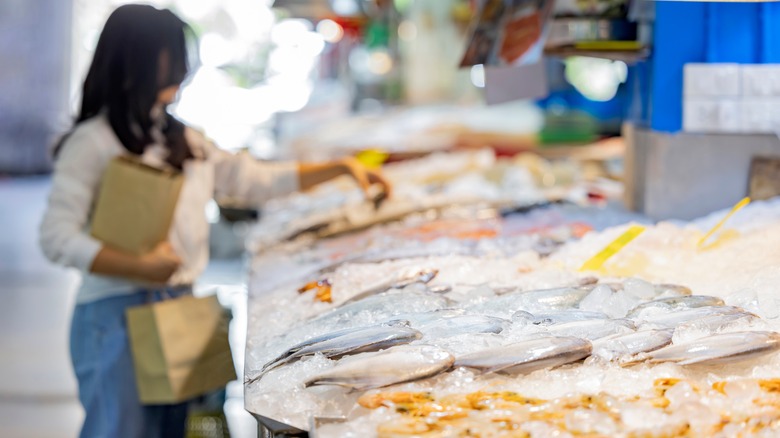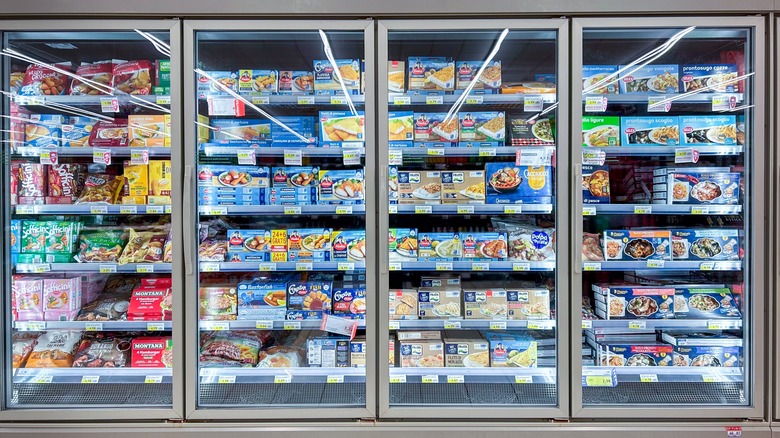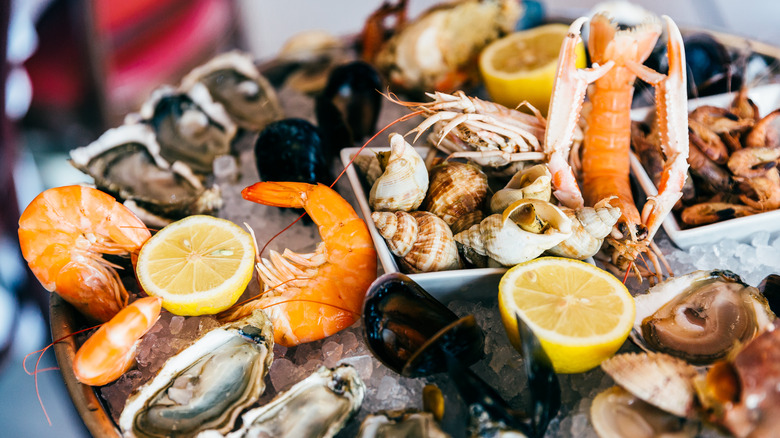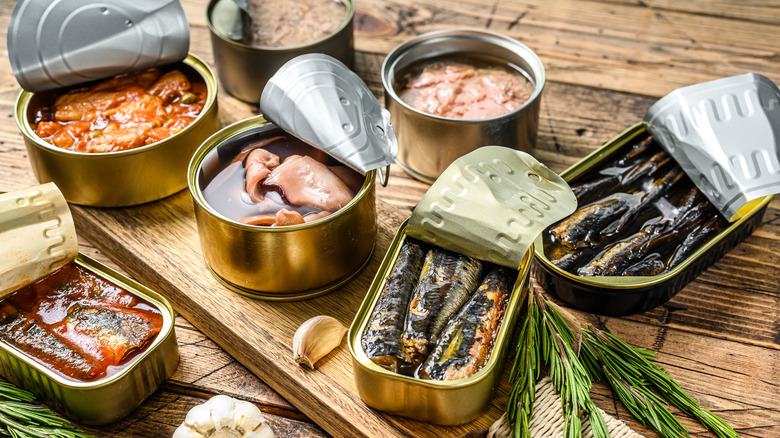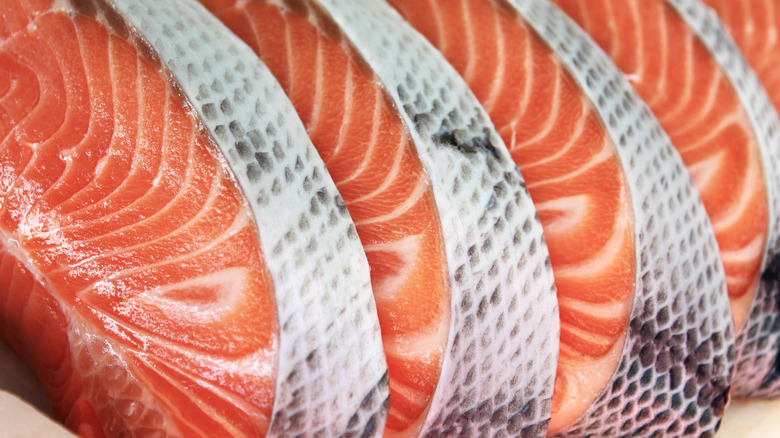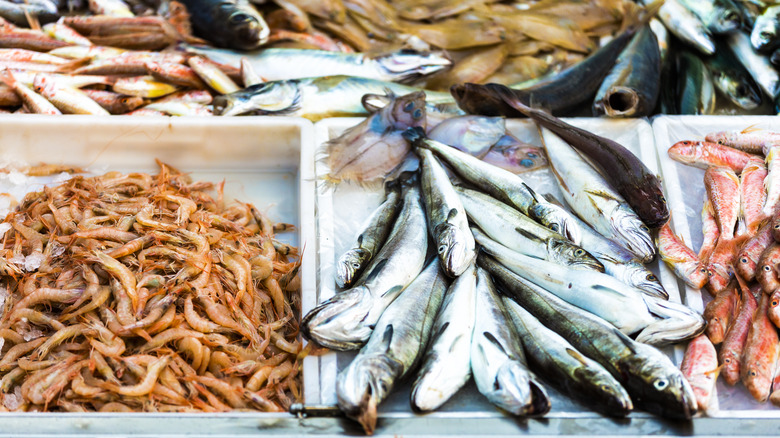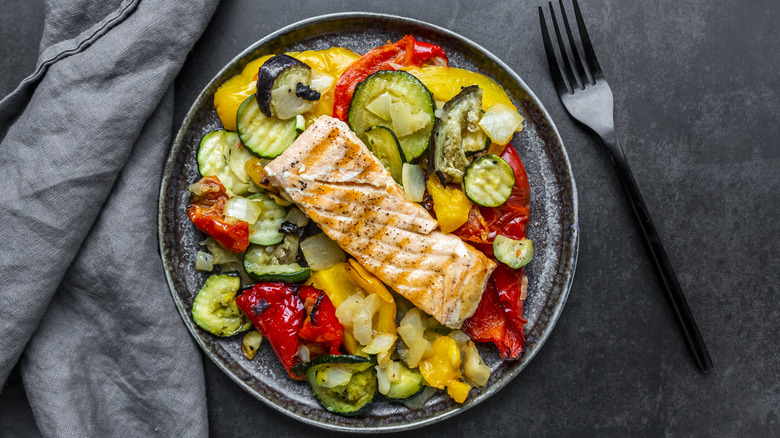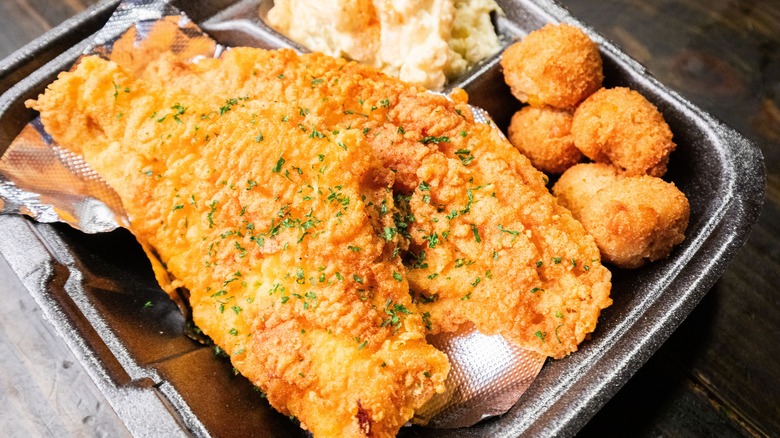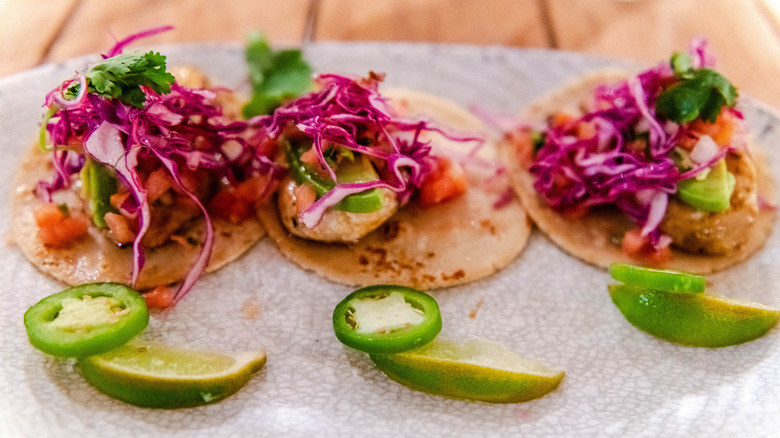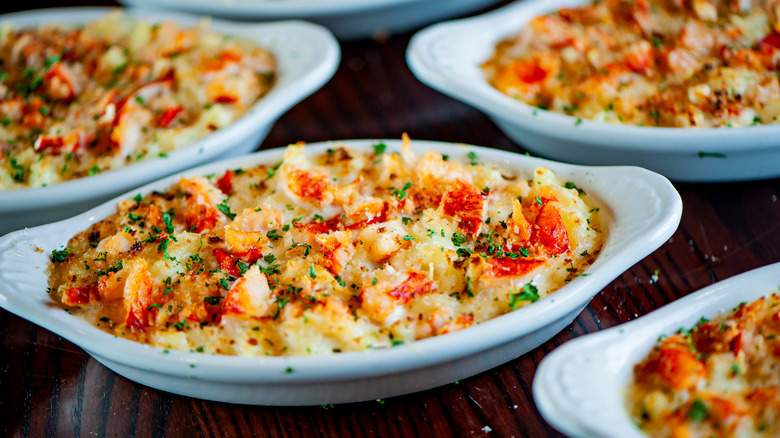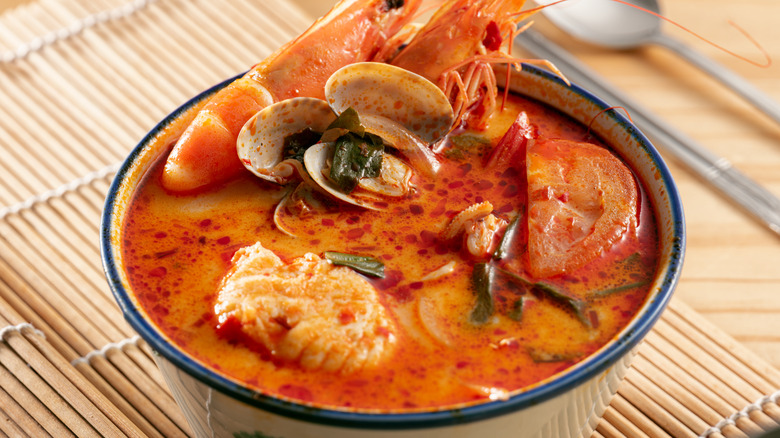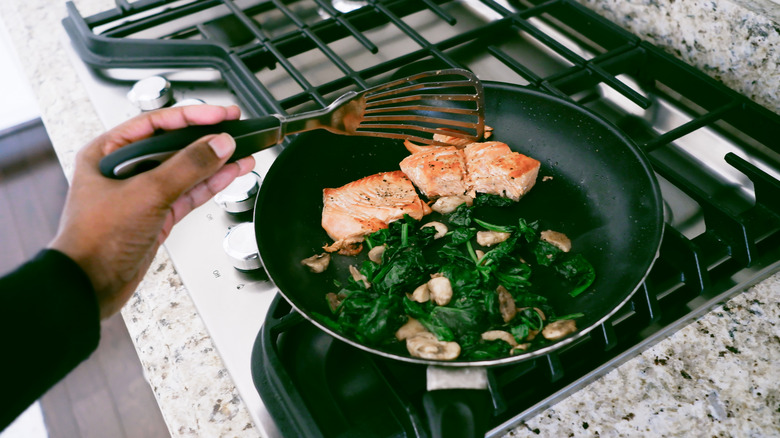Expert Advice: 11 Ways To Cut Costs When Buying Seafood
Seafood is a delicious and healthy alternative to other protein sources like chicken or steak — but it can sometimes come with a sky-high price tag. Sought-after varieties like lobster, crab, and tuna will quickly run up your grocery bill and eat into your budget. Luckily, however, you don't have to cut out your fish favorites just to squeeze them into your weekly or monthly allotment. Instead, making a few swaps and planning in advance can help you cut costs while still incorporating the fish you love.
Mashed spoke with Bryan Szeliga, founder and owner of Fishtown Seafood, to get his expert insights on how to cut costs without sacrificing on quality. "You can always come up with creative ways to use the product in making a meal or dish that will help make them very affordable," he explained. Read on to discover our top tips for easy ways to save on seafood during your next trip to the grocery store or fish market.
1. Opt for frozen seafood
When you're checking items off your grocery list, don't forget to swing through the frozen section instead of the fishmonger to see if you can score a deal. Frozen seafood is usually 20% cheaper than fresh cuts, making it an easy way to lower your grocery bill — and even better if you can score an extra sale price on top. "Look to buy frozen seafood that is on sale. A buy one, get one half off on frozen shrimp is always a great deal," said Bryan Szeliga.
While it may seem suspicious to purchase cuts that are so markedly cheaper, don't worry. Most fresh fish you buy at the seafood counter has also been frozen at some point to maintain freshness while imported (and is thawed before selling). Frozen seafood is usually also less expensive because it's not as time-sensitive to transport and doesn't have a short shelf-life. Buying your fish already frozen skips a step and helps keep money in your pocket. What's not to love?
2. Consider shellfish
When you think of fish, your mind might immediately go to varieties like salmon, tuna, or cod. But don't forget a whole other subset of our favorite marine protein: shellfish.
"[Shellfish is] a great option for a home chef," said Bryan Szeliga. "Typically, prices for oysters at a market are between $1.50 and $2 per oyster, while about $4 at a restaurant, so learning the life skill of shucking can be a great way to eat seafood and help you host a great party!" Along with oysters, clams, and mussels are also affordable ingredients that you can cook up.
If you want to recreate a gourmet shellfish meal at home, you can steam your favorite variety and pair it with butter, white wine, or even coconut curry sauce. "Steamed clams or mussels with a grilled baguette can make a perfect meal in the summer or winter," he added.
3. Choose canned and tinned fish instead of fresh
Buying tinned or canned versions of your favorite fish varieties is the ultimate way to cut costs – and is also trending online. While this is typically significantly more affordable, tinned fish also has a much longer shelf life so you can easily keep it on hand for fast and easy meals.
While canned tuna is a kitchen classic in many homes, expand your horizons to other canned varieties like crab, lobster, or sardines – many of which you can find for less than $3.99 per can. Some restaurants are even hopping on the tinned fish bandwagon, like Saltie Girl in Boston, and offering entire tinned fish menus for connoisseurs – but you can enjoy the trend at home for a fraction of the cost.
Along with canned fish powerhouses like StarKist and Chicken of the Sea, many smaller brands have also entered the market to reimagine tinned fish. Female-founded brand Fishwife offers delicious smoked salmon and trout varieties, while Los Angeles-based brand Siesta offers squid, mussels, and sardines packed in EVOO.
4. Buy skin-on fish
Though some people may be hesitant to buy skin-on fillets, it's an easy, low-impact way to reduce your seafood spending. "Buy skin on most fish. You avoid the waste, and you pay for the skin either way, so you might as well learn to cook with the skin on," said Bryan Szeliga.
Another added bonus? Fish skin is packed with nutrients, which can make your healthy meal even more nutritious. It's filled with iron, omega-3 fatty acids, and vitamins D and E – and it tastes delicious, too. "The skin is often very sweet in flavor and fish with delicate skin, like walleye or black cod, can be eaten with a variety of cooking methods. When scales are left on species, like salmon, the skin can become very crispy and is one of the best attributes of a seared salmon," Szeliga explained. Before cooking, just be sure that the fish skin has already been cleaned and scaled (if needed) to ensure it's ready to eat.
5. Buy in-season varieties
Though you may only think about shopping seasonally when it comes to produce, different fish varieties have different seasons, too. Fish that's in season tends to be more plentiful, and as a result, more affordable. It also helps you get the freshest and most flavorful fish available, making it a win-win way to plan your next meal.
Salmon is available throughout the second half of the year, while mahi mahi is available throughout the spring and summer. Different shellfish are accessible throughout the year, with lobster season falling between August and March, oysters September through April, and crawfish November through July. Cod and trout are available year-round, making them a safe option if you're not sure what's in season next time you stop into the grocery store. Frozen fish and shellfish are also always good fallbacks because they are caught, processed, and frozen when at their peak.
6. Use smaller portions
While your initial instinct may be to serve a large, fish-packed serving, reconsider your portion sizing to help keep within your budget. "The dietary guidelines for seafood are just 8 ounces per week," said Bryan Szeliga. While 6 to 8 ounces is considered an entree portion for fish fillets, you can supplement with other ingredients or instead use seafood as an appetizer (for which portion sizes are only 3 to 4 ounces per person).
Bulk up your meals with other filling ingredients, like vegetables, pasta, or bread, to create a well-rounded, nutritious, and satisfying meal. "A Taco Tuesday chicken replaced with mahi [mahi] or shrimp, bacon for breakfast replaced with smoked salmon, or a steak replaced [with] fish n' chips once a week can be affordable options."
Another option for a crowd is a seafood boil. "[This] is my favorite meal to prepare for a party, you can load up on sausage, corn, shrimp, and potatoes to help limit the amount of Dungeness crab used," he added.
7. Swap in cost-effective seafood varieties
Flashy seafood varieties often come with a matching price tag. And while it may be tempting to add these to your grocery list for the "wow" factor, instead seek out similar flavors and textures in more affordable varieties. "Some seafood like lobster, Chilean sea bass, halibut, scallops, and quality tuna have a high price per pound," explained Bryan Szeliga. But you can achieve a similar taste with cheaper alternatives, so you don't have to lighten your wallet to create a delicious and decadent meal.
Certain dishes, like Italian-American seafood stew cioppino or chowder, are well-suited for more affordable swaps. "You can make it interesting by using a fish such as monkfish, a lower cost option to lobster," he said. Instead of sea bass, try branzino or red snapper for similar flavor and texture, or choose haddock or grouper instead of mahi mahi. Other cost-effective fish varieties to consider include catfish, mackerel, or dorade.
8. Get creative with leftovers
The prospect of eating microwaved leftover fish can be a bit grim — and as a result, it can lead you to food waste (that can also hurt your bottom line). Instead of tossing your extras in the trash, you can think of inventive ways to reuse your cooked fish to make it feel new and fresh the next day.
You can use the fish to make salads, grain bowls, or sandwiches with whatever other ingredients you have, making it the perfect end-of-the-week, fridge clean-out meal. Fish cakes topped with a delicious aioli are a great option that can help mask any dryness from the previous day. Delicious fish tacos are another tried-and-true staple for leftovers that pack a lot of flavor with minimal effort on your part. Just be sure to avoid microwaving or re-searing your fish, which can leave it dried out and flavorless.
9. Stretch your seafood further
A big fillet of fish doesn't always have to be the star of your dish. Instead of thinking of seafood as the main protein, reframe your mindset and consider it one ingredient of many for your next meal. "Lobster mac n' cheese is one of my favorite ways to eat lobster. It allows you to showcase the lobster without having to give each person a full lobster tail," said Bryan Szeliga. This homemade version will not only taste great, but is delicious enough to compete with some of our chain restaurant faves.
Amping up ramen with your favorite seafood is another one of his favorite hacks. "Buy peeled and deveined, tail-off shrimp for this application and simply add to the noodles for the last few minutes of cooking. If you buy 21 [to] 25 shrimp (that is how many per pound), you can add about four to five shrimp and make 1 pound of shrimp last about five meals."
10. Minimize waste
To stretch your money even further, try to use every part of the fish. That way, you not only get your money's worth but you can also stock your pantry and fridge with delicious ingredients for future meals. You can use the fish bones, head, skin, and even shellfish shells to make delicious fish stock. You can also stash the frozen stock in your freezer for about a month and utilize it for multiple recipes over the following weeks.
Making fish stock, like all stock, is simple. All you need is your fish trimmings, a few herbs, and a handful of fresh ingredients like celery, carrots, onion, and lemon. Cook the ingredients on low heat for a few hours before straining and voila — your stock is ready to eat. You can then use it in a wide range of recipes; everything from risotto to chowder to paella is more flavorful when using this umami-packed homemade ingredient.
11. Cook at home instead of dining out
It's no surprise that ordering fish — or anything for that matter — often comes with a steep markup at restaurants. Even affordable seafood varieties, like shellfish, quickly add up when ordered out. As of 2020, Red Lobster, for example, charged almost $11 for a shrimp cocktail — which could be made at home for less than $2. It's no wonder then, that the average American spends $166 monthly at restaurants.
While dining out comes at a premium, ordering fish at restaurants (and especially expensive varieties like lobster or crab) can be even more costly than more affordable proteins like chicken. You may also notice that many fish dishes at restaurants are listed as "market price." While this amount factors in the price of the fish itself, it's also inflated to include other ingredients, labor, and profits – so the final price will be much higher than the cost of the seafood alone. Try instead recreating your favorite fish dish at home for a noticeably more affordable alternative.
